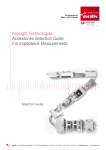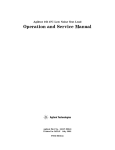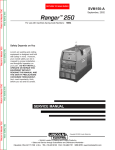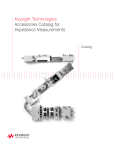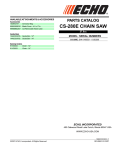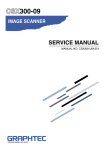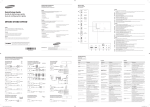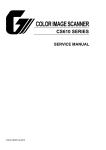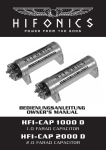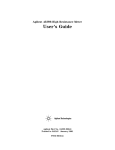Download Manual Change - Agilent Technologies
Transcript
Agilent 16008B Bias RESISTIVELY CELL Operation and Service Manual Manual Change Agilent Part No. NA August 2008 Change 1 Replace the Caution in 2-5 with the following sentences. Caution You must handle the DUT contact of Guard electrode carefully because it is made from a soft material and is easily scratched. You must keep the flatness between the Main electrode and the Guard electrode. In case of being uneven between the Main electrode and the Guard electrode, the Main electrode may not connect with the DUT correctly. Change 2 Replace step 1of the “Open Correction Procedure” in 3-3 with the following sentences. 1. Turn the load knob counterclockwise (CCW) until the distance between the upper electrode and the lower electrode is about 10mm. Note: If turning the load knob counterclockwise until the upper electrode does not move, there is a risk that the cover is not close-fitting enough. Change 3 Replace the parts in the “Replacement Parts” with the following table. Page Reference Designator Agilent Part Number 4-4 4-4 4-6 4-9 4-10 4-10 4-10 4-14 4-16 4-19 5 9 3 17 1 2 16 2 11 8 C Copyright 2008 Agilent Technologies ○ 0403-0786 0403-0833 Delete 16008-68051 16008-25086 16008-25052 8710-2100 16008-25056 0890-2300 0403-0833 16008-60191 Description Bumper Foot Bumper Foot Jumper Wire Insulator Bushing Probe Contact Insulator Tube Flex Bumper Foot Carrying Case Agilent 16008B Resistivity Cell Operation and Service Manual Agilent Part No. 16008-90011 Printed in JAPAN March 2000 Third Edition Notice The information contained in this document is subject to change without notice. This document contains proprietary information which is protected by copyright. All rights are reserved. No part of this document may be photocopied, reproduced, or translated to another language without the prior written consent of the Agilent Technologies. Agilent Technologies Japan, Ltd. Component Test PGU-Kobe 1-3-2, Murotani, Nishi-ku, Kobe-shi, Hyogo, 651-2241 Japan Warranty This Agilent Technologies instrument product is warranted against defects in material and workmanship for a period of one year from the date of shipment, except that in the case of certain components listed in this manual, the warranty shall be for the specied period. During the warranty period, Agilent Technologies will, at its option, either repair or replace products which prove to be defective. For warranty service or repair, this product must be returned to a service facility designed by Agilent Technologies. The Buyer shall prepay shipping charges to Agilent Technologies and Agilent Technologies shall pay shipping charges to return the product to the Buyer. However, the Buyer shall pay all shipping charges, duties, and taxes for products returned to Agilent Technologies from another country. Agilent Technologies warrants that its software and rmware designed by Agilent Technologies for use with an instrument will execute its programming instruction when property installed on that instrument. Agilent Technologies does not warrant that the operation of the instrument, or software, or rmware will be uninterrupted or error free. Limitation of Warranty The foregoing warranty shall not apply to defects resulting from improper or inadequate maintenance by the Buyer, Buyer-supplied software or interfacing, unauthorized modication or misuse, operation outside of the environmental specications for the product, or improper site preparation or maintenance. No other warranty is expressed or implied. Agilent Technologies specically disclaims the implied warranties of merchantability and tness for a particular purpose. Certication The Agilent Technologies certies that this product met its published specications at the time of shipment from the factory. Agilent Technologies further certies that its calibration measurements are traceable to the United States National Institute of Standards and Technology, to the extent allowed by the Institute's calibration facility, or to the calibration facilities of other International Standards Organization members. Exclusive Remedies The remedies provided herein are the buyer's sole and exclusive remedies. Agilent Technologies shall not be liable for any direct, indirect, special, incidental, or consequential damages, whether based on contract, tort, or any other legal theory. Assistance Product maintenance agreements and other customer assistance agreements are available for Agilent Technologies products. If you need assistance, contact your nearest Agilent Technologies Sales and Service Oce. Addresses are provided at the back of this manual. c Copyright 1992,1999,2000 Agilent Technologies Japan, Ltd. Manual Printing History The manual printing date and part number indicate its current edition. The printing date changes when a new edition is printed. (Minor corrections and updates which are incorporated at reprint do not cause the date to change.) The manual part number changes when extensive technical changes are incorporated. March 1992 : : : : : : : : : : : : : : : : : : : : : : : : : : : : : : : : : : : : : : : : : : : First Edition (part number: 16008-90010) July 1999 : : : : : : : : : : : : : : : : : : : : : : : : : : : : : : : : : : : : : : : : : : Second Edition (part number: 16008-90011) March 2000 : : : : : : : : : : : : : : : : : : : : : : : : : : : : : : : : : : : : : : : : : : Third Edition (part number: 16008-90011) iv Safety Summary The following general safety precautions must be observed during all phases of operation, service, and repair of this instrument. Failure to comply with these precautions or with specic WARNINGS elsewhere in this manual may impair the protection provided by the equipment. In addition it violates safety standards of design, manufacture, and intended use of the instrument. The Agilent Technologies assumes no liability for the customer's failure to comply with these requirements. Note 16008B is designed for use in INSTALLATION CATEGORY I according to IEC 61010-1 and POLLUTION DEGREE 1 according to IEC 61010-1 and IEC 60664-1. 16008B is an INDOOR USE product. Do NOT operate in an Explosive Atmosphere Do not operate the instrument in the presence of ammable gasses or fumes. Operation of any electrical instrument in such an environment constitutes a safety hazard. Keep Away from Live Circuits Operating personnel must not remove instrument covers. Component replacement and internal adjustments must be made only by qualied maintenance personnel. Do not replace components with the power cable connected. Under certain conditions, dangerous voltages may exist even with the power cable removed. To avoid injury, always disconnect power and discharge circuits before touching them. Do NOT Service or Adjust While Alone Do not attempt internal service or adjustment unless another person, capable of turning o power and capable of rendering rst aid and resuscitation, is present. Do NOT Substitute Parts or Modify Instrument Because of the danger of introducing additional hazards, do not substitute parts or perform unauthorized modications to the instrument. Return the instrument to a Agilent Technologies Sales and Service Oce for service and repair to ensure the safety features are maintained. Dangerous Procedure Warnings Warnings, such as the example below, precede POTENTIALLY DANGEROUS PROCEDURES throughout this manual. Instructions contained in the warnings must be followed. Warning Dangerous voltages, capable of causing death, are present in this instrument. Use extreme caution when handling, testing, and adjusting this instrument. v Safety Symbols General denitions of safety symbols used on equipment or in manuals are listed below. Instruction manual symbol: the product is marked with this symbol when it is necessary for the user to refer to the instruction manual. Alternating current. Direct current. On (Supply). O (Supply). This Warning sign denotes a hazard. It calls attention to a procedure, practice, condition or the like, which, if not correctly performed or adhered to, could result in injury or death to personnel. This Caution sign denotes a hazard. It calls attention to a procedure, practice, condition or the like, which, if not correctly performed or adhered to, could result in damage to or destruction of part or all of the product. Note denotes important information. It calls attention to a procedure, practice, condition or the like, which is essential to highlight. Axed to product containing static sensitive devices use anti-static handling procedures to prevent electrostatic discharge damage to component. Caution, risk of electric shock : Terminals which may be supplied from the interior of the equipment at a voltage exceeding 1 kV, or allow connection to a voltage exceeding 1 kV are marked with this symbol. vi Contents 1. General Information Introduction . . . . . . . . . . . . . . . Using the 16008B . . . . . . . . . . . . Product Description . . . . . . . . . . . Accessories Supplied . . . . . . . . . . . Options . . . . . . . . . . . . . . . . . Operating and Safety Precautions . . . . . Service . . . . . . . . . . . . . . . . Specications . . . . . . . . . . . . . . Supplemental Performance Characteristics . . . . . . . . . . . . . . . . . . . . . . . . . . . . . . . . . . . . . . . . . . . . . . . . . . . . . . . . . . . . . . . . . . . . . . . . . . . . . . . . . . . . . . . . . . . . . . . . . . . . . . . . . . . . . . . . . . . . . . . . . . . . . . . . . . . . . . . . . . . . . . . . . . . . . . . . . . . . . . . . . . 1-1 1-1 1-1 1-2 1-2 1-2 1-2 1-2 1-3 Introduction . . . . . . . . . . . . . . . . . . . Initial Inspection . . . . . . . . . . . . . . . . . Ambient Environmental Considerations . . . . . . Operating and Storage . . . . . . . . . . . . . Using the 16008B in an Environmental Test Oven Exchanging the Electrode . . . . . . . . . . . . Connecting the Adapter for Use . . . . . . . . . Repackaging the Adapter . . . . . . . . . . . . . . . . . . . . . . . . . . . . . . . . . . . . . . . . . . . . . . . . . . . . . . . . . . . . . . . . . . . . . . . . . . . . . . . . . . . . . . . . . . . . . . . . . . . . . . . . . . . . . . . . . . . . . . . . . . . . . 2-1 2-1 2-3 2-3 2-3 2-4 2-6 2-6 . . . . . . . . . . . . . . . . . . . . . . . . . . . . . . . . . . . . . . . . . . . . . . . . . . . . . . . . . . . . . . . . . . . . . . . . . . . . . . . . . . . . . . . . . . . . . . . . . . 3-1 3-3 3-3 3-4 3-5 3-6 3-6 Introduction . . . . . . . . . . . . . . . . . . . . Safety Considerations . . . . . . . . . . . . . . . Assembly Replacement (General Information) . . . . Assembly Replacement (Main Body) . . . . . . . . . How to start disassembling the main body . . . . . Top Cover Removal . . . . . . . . . . . . . . . Micro Switch Adjustment . . . . . . . . . . . . . Replaceable Parts . . . . . . . . . . . . . . . . Contact Assembly . . . . . . . . . . . . . . . Spring Unit . . . . . . . . . . . . . . . . . . Assembly Replacement (Volume/Surface Selector Box) Replaceable Parts . . . . . . . . . . . . . . . . Assembly Replacement (Cable Assembly) . . . . . . Do NOT forget Cable Tie . . . . . . . . . . . . . High Voltage Consideration . . . . . . . . . . . . . . . . . . . . . . . . . . . . . . . . . . . . . . . . . . . . . . . . . . . . . . . . . . . . . . . . . . . . . . . . . . . . . . . . . . . . . . . . . . . . . . . . . . . . . . . . . . . . . . . . . . . . . . . . . . . . . . . . . . . . . . . . . . . . . . . . . . . . . . . . . . . . . . . . . . . . . . . . . . . . . . . . . . . . . . . . . . . . . . . . . . . . . . . . . . . . . . . 4-1 4-1 4-1 4-3 4-3 4-3 4-3 4-4 4-7 4-10 4-11 4-11 4-12 4-12 4-12 2. Preparation for Use 3. Operation Introduction . . . . . . . . . OPEN Correction . . . . . . Applying Contact Pressure . . Operation . . . . . . . . . . Removing the Upper Electrode Care of the Electrodes . . . . Checking Procedure . . . . . 4. Service . . . . . . . . . . . . . . . . . . . . . . . . . . . . . . . . . . . . . . . . . . . . . . . . . . . . . . . . . . . . . . . . . . . . . . Contents-1 Replaceable Parts . . . . . . . . . . . . . . . Assembly Replacement (Upper Electrode) . . . . . Upper Electrode Disassembly . . . . . . . . . . Replaceable Parts . . . . . . . . . . . . . . . Assembly Replacement (Lower Electrodes) . . . . Disassembly Procedure . . . . . . . . . . . . . Replaceable Parts . . . . . . . . . . . . . . . Troubleshooting . . . . . . . . . . . . . . . . . Schematic Diagram . . . . . . . . . . . . . . Cable Connection Check . . . . . . . . . . . . BNC Cable and Triaxial Cable Connection Check Interlock Circuit Connection Check . . . . . . Contents-2 . . . . . . . . . . . . . . . . . . . . . . . . . . . . . . . . . . . . . . . . . . . . . . . . . . . . . . . . . . . . . . . . . . . . . . . . . . . . . . . . . . . . . . . . . . . . . . . . . . . . . . . . . . . . . . . . . . . . . . . . . . . . . . . . . . . . . . . . . . . . . . . . . . . . . . . . . . . . . . . . . . . . . . . . 4-12 4-15 4-15 4-15 4-18 4-18 4-18 4-20 4-20 4-21 4-21 4-22 Figures 2-1. 2-2. 2-3. 2-4. 3-1. 3-2. 3-3. 3-4. 4-1. 4-2. 4-3. 4-4. 4-5. 4-6. 4-7. 4-8. Product Overview . . . . . . . . . . . 16008B in an Environmental Test Oven . Exchanging the Electrode . . . . . . . Connecting the Adapter . . . . . . . . External Appearance . . . . . . . . . Electrode Appearance . . . . . . . . . Load Scale . . . . . . . . . . . . . . Latch . . . . . . . . . . . . . . . . . Main Body Disassembly . . . . . . . . Parts Identication for Contact Assembly Do NOT forget the Cable ties. . . . . . . High Voltage Consideration . . . . . . . Cable Connection of 16008B . . . . . . Upper Electrode Disassembly . . . . . . Schematic Diagram of 16008B . . . . . Cable Connection Check . . . . . . . . . . . . . . . . . . . . . . . . . . . . . . . . . . . . . . . . . . . . . . . . . . . . . . . . . . . . . . . . . . . . . . . . . . . . . . . . . . . . . . . . . . . . . . . . . . . . . . . . . . . . . . . . . . . . . . . . . . . . . . . . . . . . . . . . . . . . . . . . . . . . . . . . . . . . . . . . . . . . . . . . . . . . . . . . . . . . . . . . . . . . . . . . . . . . . . . . . . . . . . . . . . . . . . . . . . . . . . . . . . . . . . . . . . . . . . . . . . . . . . . . . . . . . . . . . . . . . . . . . . . . . . . . . . . . . . . . . . . . . . . . . . . . . . . . 2-2 2-4 2-5 2-6 3-1 3-2 3-3 3-5 4-3 4-8 4-12 4-12 4-13 4-15 4-20 4-21 Furnished Accessories . . . . . . . . . . . . . . Supplied Options . . . . . . . . . . . . . . . . . Contents . . . . . . . . . . . . . . . . . . . . Replaceable Parts (Overview) . . . . . . . . . . . Replaceable Parts for Main Body (External View) . Replaceable Parts for Main Body (Top View) . . . . Replaceable Parts for Main Body (Bottom View) . . Replaceable Parts for Contact Assembly . . . . . . Replaceable Parts for Spring Unit . . . . . . . . . Replaceable Parts for Volume/Surface Selector Box . Replaceable Parts for the Cable Assembly . . . . . Replaceable Parts for Upper Electrode (1 of 2) . . . Replaceable Parts for Upper Electrode (2 of 2) . . . Replaceable Parts for Lower Electrodes . . . . . . 6-pin cable connections . . . . . . . . . . . . . . . . . . . . . . . . . . . . . . . . . . . . . . . . . . . . . . . . . . . . . . . . . . . . . . . . . . . . . . . . . . . . . . . . . . . . . . . . . . . . . . . . . . . . . . . . . . . . . . . . . . . . . . . . . . . . . . . . . . . . . . . . . . . . . . . . . . . . . . . . . . . . . . . . . . . . . . . . . . . . . . . . . . . . . . . . . . . . . . . . . . . . . . . . . . . . . . . . 1-2 1-2 2-2 4-2 4-4 4-5 4-6 4-9 4-10 4-11 4-14 4-16 4-17 4-19 4-22 Tables 1-1. 1-2. 2-1. 4-1. 4-2. 4-3. 4-4. 4-5. 4-6. 4-7. 4-8. 4-9. 4-10. 4-11. 4-12. Contents-3 1 General Information Introduction The purpose of this manual is to enable you to use your 16008B Resistivity Cell eciently and condently. This manual contains both general and specic information. To use the 16008B to perform a specic function (without having to read the entire manual), follow the directions in \Using the 16008B". Using the 16008B The 16008B has been designed to operate specically with the 4339B High Resistance Meter. To install the 16008B, turn to Chapter 2. To operate the 16008B, turn to Chapter 3. To order replaceable parts for the 16008B, turn to Chapter 4. Product Description The 16008B has been designed to operate specically with the 4339B High Resistance Meter. The 16008B is used to measure the volume or surface resistance/resistivity of insulation materials. The 16008B has the following features: Electrode size selectable; Three dierent size electrodes to meet your DUT size requirements and to meet to electrode size requirements required by dierent standards. Can be used in -30 C to 100 C ambient environments Arbitrary contact pressure can be applied on DUT General Information 1-1 Accessories Supplied The accessories listed in Table 1-1, are supplied with the 16008B: Table 1-1. Furnished Accessories Description Part Number Operation and Service Manual P/N 16008-90010 Quantity 1 Options The following options are supplied for the 16008B: Product Number 16008B Option 001 Option 002 Option 003 Table 1-2. Supplied Options Description Add 26/76 mm diameter electrodes (with carrying case) Add 26 mm diameter electrode (with carrying case) Add 76 mm diameter electrode (with carrying case) Operating and Safety Precautions Service The voltage levels (up to 1000 V) in this adapter warrants extreme care for operator safety. Service must be performed only by qualied personnel. Specications This section lists the complete 16008B specications. These specications are the performance standards and limits against which the 16008B is tested. When shipped from the factory, the 16008B meets the following listed specications: Measurement Parameter : : : : : : : : : : Volume Resistance/Resistivity, Surface Resistance/Resistivity Applicable Test Voltage : : : : : : : : : : : : : : : : : : : : : : : : : : : : : : : : : : : : : : : : : : : : : : : : : : : : : : : : 1000 V maximum Applicable Test Current1 : : : : : : : : : : : : : : : : : : : : : : : : : : : : : : : : : : : : : : : : : : : : : : : : : : : : : : : 10 mA maximum Applicable Instrument : : : : : : : : : : : : : : : : : : : : : : : : : : : : : : : : : : : : : : : : : : : : : : : : : : : : : : : : : : : : : : : : : : : : : 4339B Interlock Circuit : : : : : : : : : : : : : : : : : : : : : : : : : : : : : : : : : : : : : : : : : : : : : : : : : : : : : : : : : : : : : : : : : : : : : : : furnished Operating Temperature : : : : : : : : : : : : : : : : : : : : : : : : : : : : : : : : : : -30 to 100 C (connector: 0 to 55 C ) Operating Humidity : : : : : : : : : : : : : : : : : : : : : : : : : : : : : : : : : : : : : : : : : : : : : : : : : : : : : : : : : : 70% RH (@40 C) Cable Length : : : : : : : : : : : : : : : : : : : : : : : : : : : : : : : : : : : : : : : : : : : : : : : : : : : : : 1.2 m (connector to electrode) Weight : : : : : : : : : : : : : : : : : : : : : : : : : : : : : : : : : : : : : : : : : : : : : : : : : : : : : : : : : : : : : : : : : : : : : : : : : : : : : : : : : : : : : : : 7 kg Non-operating Temperature : : : : : : : : : : : : : : : : : : : : : : : : : : : : : : : : : : : : : : : : : : : : : : : : : : : : : : : : 040 to 70 C Non-operating Humidity : : : : : : : : : : : : : : : : : : : : : : : : : : : : : : : : : : : : : : : : : : : : : : : : : : : : : : 95% RH (@40 C) 1-2 General Information 1. The 4339B limits a maximum test current to 10 mA when using with the 16008B. Maximum measurable current of the 4339B is 100 A. Supplemental Performance Characteristics This section gives supplemental performance characteristics. Supplemental performance characteristics are not specications, but are typical characteristics included as additional information for the operator. Supplemental performance characteristics are not guaranteed. Resistivity Measurement Range 1 Volume Resistivity : : : : : : : : : : : : : : : : : : : : : : : : : : : : : : : : : : : : : : : : : : : : : : : : : : : : : : : : up to 4.021018 cm Surface Resistivity : : : : : : : : : : : : : : : : : : : : : : : : : : : : : : : : : : : : : : : : : : : : : : : : : : : : : : : : : : : up to 4.021017 Leakage Current 2 : : : : : : : : : : : : : : : : : : : : : : : : : : : : : : : : : : : : : : : : : : : : : : : : : : : : : : : : : : : : : : less than 1.0 pA Stability 2 : : : : : : : : : : : : : : : : : : : : : : : : : : : : : : : : : : : : : : : : : : : : : : : : : : : : : : : : : : : : : : : : : : : : : : : less than 0.5 pA Applicable DUT (Device Under Test) Size : : : : : : : : : : : : : : : : : : : : : : : : : : 50 mm to 125 mm diameter Applicable DUT Thickness : : : : : : : : : : : : : : : : : : : : : : : : : : : : : : : : : : : : : : : : : : : : : : : : : : : : : : 10 m to 10 mm Electrode Size Main Electrode Guard Electrode3 Note 26 mm 38 mm option 50 mm 70 mm furnished 76 mm 88 mm option Operating Load : : : : : : : : : : : : : : : : : : : : : : : : : : : : : : : : : : : : : : : : : : : : : : : : : : : : : : : : : : : : : : : : 10 kgF maximum Dimensions : : : : : : : : : : : : : : : : : : : : : : : : : : : : : : : : : : : : : : : : : : : : : : : : : : : 240 (W) 2 180 (H) 2 240 (D) [mm] Cable Length : : : : : : : : : : : : : : : : : : : : : : : : : : : : : : : : : : : : : : : : : : : : : : : : : : : : : : : : : : : : : : : : : : : : : : : : : : : : : : 1.20 m Main body to Selector box : : : : : : : : : : : : : : : : : : : : : : : : : : : : : : : : : : : : : : : : : : : : : : : : : : : : : : : : : : : : : 0.82 m 1.After compensation, measurement time is LONG, 50/70 mm electrode, 23 6 5 C, 50% RH 2.After 1000 V has been applied for 1 minute, in no vibration and shock environment, and under the same conditions as 1 3. Inside diameter General Information 1-3 2 Preparation for Use Introduction This chapter explains how to install the 16008B Resistivity Cell. The topics covered include initial inspection, ambient environmental considerations, connecting the adapter for use, and repackaging the adapter for shipping. Initial Inspection The adapter has been carefully inspected electrically and mechanically before being shipped from the factory. It should be in perfect physical condition, no scratches, dents or the like, and it should be in perfect electrical condition. Verify this by carefully performing an incoming inspection to check the adapter for signs of physical damage and missing contents. If any discrepancy is found, notify the carrier and Agilent Technologies. Your Agilent Technologies sales oce will arrange for repair and replacement without waiting for the claim to be settled. 1. Inspect the shipping container for damage, and keep the shipping materials until the incoming inspection is completed. 2. Verify that the shipping container contains everything shown in Figure 2-1 and listed in Table 2-1. 3. Inspect the exterior of the 16008B for any signs of damage. Preparation for Use 2-1 Figure 2-1. Product Overview Table 2-1. Contents Agilent Part Number Description 1 Resistivity Cell 2 Acrylic Plate 3 Operation and Service Manual1 16008B 16008-1033 16008-90020 1 Operation and Service Manual is not shown in Figure 2-1. 2-2 Preparation for Use Quantity 1 1 1 When an option is ordered with the 16008B, the following items are included: Option 001 Description Agilent Part Number Quantity Description Agilent Part Number Quantity Description Agilent Part Number Quantity 26 mm main electrode 38 mm guard electrode 76 mm main electrode 88 mm guard electrode spare screw carrying case 16008-60083 16008-24084 16008-60085 16008-24086 0515-0907 16008-60181 1 1 1 1 3 1 Option 002 26 mm main electrode 38 mm guard electrode spare screw carrying case 16008-60083 16008-24084 0515-0907 16008-60181 1 1 3 1 Option 003 76 mm main electrode 88 mm guard electrode spare screw carrying case 16008-60085 16008-24086 0515-0907 16008-60181 1 1 3 1 Ambient Environmental Considerations Operating and Storage The 16008B must be operated within an ambient temperature range of 030 C to +100 C and relative humidity up to 70% RH at 40 C (non-condensing). The 16008B may be stored within a temperature range of 040 C to +70 , and at a relative humidity up to 95% at +40 C (non-condensing). Using the 16008B in an Environmental Test Oven The 16008B has the capability for high-temperature measurement in environmental testing up to +100 C. This section provides information for using the 16008B in an environmental test chamber. Note If the environmental test oven temperature exceeds 100 C, the basic specications will be invalid. You must pay close attention to temperature settings. Preparation for Use 2-3 The Volume/Surface selector box must be located outside of the oven because it is not designed for operating at temperatures up to 100 C(see \Specications" in Chapter 1). To locate the box outside of the oven, the 100 mm hole is required in the oven. Figure 2-2 shows the measurement conguration when using the 4339B in an environmental test oven. Warning Figure 2-2. 16008B in an Environmental Test Oven Use globes when handling the 16008B just after it comes out of a test oven or wait until it has cooled down enough to not cause burns. Exchanging the Electrode The 16008B has two optional electrodes in addition to the furnished 50 mm electrode. You can exchange the electrode as required for your measurement. To exchange the electrode, do the following: 2-4 Preparation for Use Warning Figure 2-3. Exchanging the Electrode Do NOT touch the electrode and UNKNOWN connector while the High Voltage indicator is lit which shows the 4339B's output is a high voltage of up to 1000 Vdc maximum. You must operate after turning o the voltage source output and you have conrmed the high voltage indicator is turned o. To Change Electrodes 1. 2. 3. 4. Turn the main electrode counter clockwise to loosen it, and then remove it. Remove the three screws holding the Guard electrode in place. Remove the Guard electrode. Place the new Guard electrode so that the three holes are aligned with the three holes in the socket module. 5. Insert and Tighten the three screws. 6. Insert the new Main electrode and turn it clockwise to tighten it. 7. Conrm that the top of the Guard electrode sets higher than the top of the Main electrode. Caution You must handle the DUT contact of Guard electrode carefully because it is made from a soft material and is easily scratched. Preparation for Use 2-5 Connecting the Adapter for Use Connect the 16008B to the 4339B, as shown in Figure 2-4. You must connect BNC, triaxial, and interlock connectors. If the interlock connector is not connected, the 4339B will not output the source voltage. Warning Do NOT touch the electrode and UNKNOWN connector while the High Voltage indicator is lit which shows the 4339B's output is a high voltage of up to 1000 Vdc maximum. You must operate after turning o the voltage source output and you have conrmed the high voltage indicator is turned o. Figure 2-4. Connecting the Adapter Repackaging the Adapter If shipment to a Agilent Technologies service center is required, each adapter should be repackaged using the original factory packaging materials. Alteratively, comparable packaging materials may be used. Wrap the adapter in heavy paper and pack in anti-static plastic packing material. Use sucient shock absorbing material on all sides of the 16008B to provide a thick, rm cushion and to prevent movement. Seal the shipping container securely and mark it FRAGILE. 2-6 Preparation for Use 3 Operation Introduction This chapter describes the features of the 16008B, and connections to the 4339B and the DUT. Figure 3-1. External Appearance 1. Handle. 2. Top cover. This shields against external electrical noise and provides an interlock to enable and disable the test voltage when CLOSED and OPEN respectively. 3. Volume/Surface selector. Used to select the volume or surface measurement mode. A displayed resistivity parameter would be changed automatically interlocking with selector change. When you operate in manual or external trigger mode, displayed parameter will not change until the 4339B has triggered. Operation 3-1 Note When you change Volume and Surface mode, turn o the source voltage output of the 4339B. 4. Volume/Surface selector box. 5. BNC connector. This connector supplies the source voltage to the 16008B. This is a high voltage BNC connector and is not compatible with standard BNC connectors. 6. Triaxial connector. The measured signal is carried on the center conductor of this connector. 7. Interlock connector. This connector enables the interlock function which enables and disables application of the source voltage from the 4339B when the top cover is closed and opened respectively. When the top cover is opened, the source voltage is turned OFF inside the 4339B side. Figure 3-2. Electrode Appearance 8. Main electrode. (covered with a conductive elastomer) The negative test voltage is applied from the Output terminal of the 4339B. 9. Guard electrode. Provides the guard for Volume measurements. Applies the positive test voltage for surface measurements. 10. Upper electrode. Provides the guard for surface measurements. Applies the positive test voltage for volume measurements. 11. Load scale. This scale shows currently applied pressure in kirograms. 12. Load knob. To apply load for the DUT, turn this knob to clockwise. 3-2 Operation OPEN Correction OPEN correction compensates cancels residual resistance for resistance measurements. Warning Do NOT touch the electrodes and UNKNOWN connector while the High Voltage indicator is lit which shows the 4339B's output is a high voltage of up to 1000 Vdc maximum. You must operate after turning o the voltage source output and you have conrmed the high voltage indicator is turned o. OPEN Correction Procedure 1. 2. 3. 4. 5. 6. Turn the load knob counterclockwise(ccw) until the upper electrode does not move. Select the current measurement mode at the 4339B. Close the top cover. Apply the source voltage required for your measurement at the 4339B. Set measurement time to LONG and wait until the current has stabled to within 0.5 pA. Press keys of the 4339B to perform the OPEN correction. Note When an OPEN correction is performed, the electrodes must be separated enough to prevent leakage current from occurring which will lead to OPEN correction instability. Note Do NOT allow vibration to reach the 16008B when performing an OPEN correction. The upper electrode of the 16008B is not xed when setup for an OPEN correction, and vibration will cause the upper electrode to move about leading to OPEN correction instability. Applying Contact Pressure The 16008B can apply contact pressure on the DUT of up to approximately 10 kg. The contact pressure Load Scale shows the approximately applied contact pressure in kilograms. To adjust the contact pressure, turn the load knob clockwise (cw). Figure 3-3 shows how to read the load scale. Figure 3-3. Load Scale Operation 3-3 Caution Do NOT adjust the contact preasure setting past the 10 kg mark or the 16008B may be machanically damaged. Operation Step-by-step instructions on how to make a measurement with the 16008B are as follows: Warning Do NOT touch the electrode and UNKNOWN connector while the High Voltage indicator is lit which shows the 4339B's output is a high voltage of up to 1000 Vdc maximum. You must operate after turning o the voltage source output and you have conrmed the high voltage indicator is turned o. 1. Connect the Triaxial connector to the INPUT terminal, the BNC connector to the OUTPUT terminal, and the Interlock connector to the Interlock terminal of the 4339B. 2. Select either a surface or a volume measurement using the Volume/Surface selector. Note Turn o the voltage output when you change the Volume/Surface selector. If you change the Volume/Surface selector when voltage applied, a calibration, open correction, or oset-error cancel of the 4339A would be failed due to noise generated from the Volume/Surface selector. 3. Perform an OPEN correction as described in \OPEN Correction". 4. Place the DUT on the Main electrode, and then place the upper electrode on the DUT. 5. Turn the contact pressure load knob to adjust the electrode contact pressure on the DUT. Refer to \Applying Contact Pressure". 6. Close the Top cover. The 16008B measurement preparation is now complete. 7. Follow the measurement instructions described in the 4339A Operating Manual to perform the measurement. Caution Do NOT short the upper and lower electrodes when the voltage source is turned on. Note For surface and volume measurements, dierent voltage polarities are applied to the DUT. When changing between surface and volume measurements, the 4339B requires a settling time of at least one minute. 3-4 Operation Removing the Upper Electrode Warning Do NOT touch the electrode and UNKNOWN connector while the High Voltage indicator is lit which shows the 4339B's output is a high voltage of up to 1000 Vdc maximum. You must operate after turning o the voltage source output and you have conrmed the high voltage indicator is turned o. To Remove Upper Electrode 1. Push the latch on both sides of the upper electrode. See Figure 3-4. The lock will then be released. 2. Lift the upper electrode up and remove it. Note Figure 3-4. Latch The upper electrode may not release when you push the latch and a contact pressure load is still applied. If this happens turn the contact pressure load knob CCW to decrease the applied pressure, until the upper electrode releases. Operation 3-5 Care of the Electrodes The electrodes should be kept clean to obtain complete contact with the DUT. To clean the electrodes (except for the conductive elastomer), wipe them with a dust free cloth that has been dipped in alcohol. To avoid scratching the guard electrode when the 16008B is not in use, place the furnished acrylic plate between upper and guard electrodes, and apply a pre-load contact pressure to rmly hold the acrylic plate in place. Warning Do NOT touch the electrode and UNKNOWN connector while the High Voltage indicator is lit which shows the 4339B's output is a high voltage of up to 1000 Vdc maximum. You must operate after turning o the voltage source output and you have conrmed the high voltage indicator is turned o. Checking Procedure The 16008B and the 4339B is operated with high voltage up to 1000 V. These products are designed that the operator can measure safely. To keep the safe condition, you must execute following checking procedure periodically. Warning Do NOT touch the electrode and UNKNOWN connector while the High Voltage indicator is lit which shows the 4339B's output is a high voltage of up to 1000 Vdc maximum. You must operate after turning o the voltage source output and you have conrmed the high voltage indicator is turned o. Daily Safety Verication Procedure 1. 2. 3. 4. Connect the 16008B to the 4339B. Close the top cover of the 16008B. Set source voltage to 42 V. Press V output key of the 4339B. Conrm that the V output indicator and the High Voltage indicator turn on. 5. Open top cover of the 16008B. Conrm that the High Voltage indicator turns o immediately. 6. Close the top cover again. Conrm that the High Voltage indicator still turns o. If you encountered any errors in checking procedure, contact your nearest Agilent Technologies Oce. 3-6 Operation 4 Service Introduction This chapter covers the following subjects: Assembly Replacement Disassembly Procedure for main assembly Replaceable Parts Troubleshooting Safety Considerations This manual contains CAUTIONs which must be followed to ensure the safety of the operator and to keep the instrument in a safe and serviceable condition. Warning These servicing instructions are for use by qualied personnel only. Do NOT perform any servicing other than that contained in the operating section unless you are qualied to do so. Assembly Replacement (General Information) Table 4-1 shows all items included with the 16008B. Detailed explanations for the following ve parts are given in the sections which follow: Main Body Volume/Surface Selector Box Cable Assembly Upper Electrode Lower Electrodes Service 4-1 Table 4-1. Replaceable Parts (Overview) Reference Designator 1 2 3 4 5 6 7 8 - Agilent Part Number Not Assigned Not Assigned Not Assigned 16008-60051 16008-60071 16008-1033 0515-0907 Not Assigned 16008-90011 Qty. 1 1 1 1 1 1 3 1 1 1 includes Items 1 through 3. 2 See \Assembly Replacement (Lower Electrodes)" for each lower electrode. 3 isn't included in the above picture. 4-2 Service Description Main body Cable Assembly Volume/Surface Selector Box Main Fixture Assembly1 Upper Electrode Assembly Acrylic Plate Screw Pan M3L8 (for guard electrode) Lower Electrodes2 Operation and Service Manual3 Assembly Replacement (Main Body) This section explains complex and important points when disassembling and assembling the Main Body. The replaceable Parts List for the main body is also provided in this section. How to start disassembling the main body Open the box from the top when replacing the electrodes and parts around the electrodes. Open the box from the bottom when repairing the electrical connections. The following describes how to open the box from the top. 1. Remove both the main electrode and the guard electrode shown in \Exchanging the Electrode" in Chapter 2. 2. Remove the black plate by removing the two screws (marked with 1 ). 3. Remove the black insulator by removing the three screws (marked with 2 ). Figure 4-1. Main Body Disassembly Top Cover Removal Before removing the top cover, the screw, which pushes the micro switch closed, should be removed from the top cover. This screw is accessed by removing the bottom cover, it is mounted on the portion of the top cover which extends down into the box. Micro Switch Adjustment When the top cover or the micro switch is reassembled, the length of the screw which pushes the micro switch (P/N 16008-24051) closed must be adjusted so that it will cause the micro switch to open at the proper top cover opening angle. 1. Put a drop of Lock-Tite (P/N 0470-0013) on the screw's threads. 2. Rotate the screw clockwise until you hear the micro switch click closed ( or use the low resistance range of a multimeter and watch for the resistance change when the switch closes). 3. Rotate the screw one more full turn clockwise. Service 4-3 Replaceable Parts Table 4-2 through Table 4-4 show and list the replaceable parts for the main body. The parts listed can be ordered from your nearest Agilent Technologies Oce. Ordering information must include the Agilent part number and the quantity required. Table 4-2. Replaceable Parts for Main Body (External View) Reference Designator 1 2 3 4 5 6 7 8 9 10 Agilent Part Number 16008-60052 16008-40051 16008-60053 0515-0914 0403-0712 0515-1551 1440-0186 0515-2415 0400-0276 16008-00251 0403-0316 16008-09051 0515-0907 0515-0914 Qty. 1 1 1 2 4 4 1 2 2 1 2 1 3 3 Description Top Cover Trim Personal Bottom Cover Screw Flat M3L6 Bumper Foot Screw Pan M3L10 Handle Screw M8L16 Grommet Panel Top1 Bumper Foot Hinge Screw Flat M3L8 Screw Flat M3L6 1 One machine screw (P/N 0515-0914) on this panel. (not included in the above picture.) 4-4 Service Table 4-3. Replaceable Parts for Main Body (Top View) Reference Designator 1 2 3 4 5 6 7 8 9 10 Agilent Part Number 16008-00151 16008-60054 16008-61657 1400-1653 1400-0054 0515-2079 16008-60055 16008-40051 16008-60087 16008-00153 16008-00651 16008-25081 0515-1550 3050-0891 16008-00252 0515-0914 Qty. 1 1 1 1 1 1 1 1 1 1 1 1 4 4 1 1 Description Chassis Spring Unit Assembly Cable Assembly(White Label) Cable Tie Clamp Cable Screw Pan M4L8 Spring Unit Assembly Trim Personal Contact Assembly1 Chassis Plate Insulator Screw Flat M3L8 Washer Panel Screw Flat M3L6 1 See \Contact Assembly" for details. Service 4-5 Table 4-4. Replaceable Parts for Main Body (Bottom View) Reference Designator Agilent Part Number 3 4 5 6 16008-68051 16008-00151 16008-00251 1400-0054 0515-2079 16008-00153 16008-60055 1400-1653 0515-0914 16008-60054 1 2 7 8 9 10 11 16008-24051 Qty. 1 1 1 1 1 1 1 1 1 1 6 2 1 1 Includes nuts and bolts to mount the microswitch. 4-6 Service Description Screw to push the microswitch Microswitch Switch Cover Jumper Wire1 Chassis Panel Top Clamp Cable Screw Pan Head Chassis Spring Unit Assembly Cable Tie Screw Flat Head Spring Unit Assembly Caution 1. Use the cable tie specied in the list because it is a special cable tie which can withstand high temperatures. 2. When disassembling the top cover, the screw which pushes the micro switch closed must be removed rst. See \Top Cover Removal" for details. 3. When reassembling the top cover or the micro switch, the screw which pushes the micro switch closed must be adjusted to let the micro switch open at the proper opening angle of the top cover. See \Micro Switch Adjustment" for details. Contact Assembly Figure 4-2 and Table 4-5 show the replaceable parts for the contact assembly in the main body. Service 4-7 Figure 4-2. Parts Identication for Contact Assembly 4-8 Service Reference Designator 1 2 3 4 5 6 7 8 9 10 11 12 13 14 15 16 17 18 Table 4-5. Replaceable Parts for Contact Assembly Agilent Part Number Qty. Description 16008-60081 0515-0907 16008-24082 0515-1550 3050-0891 16008-25081 1460-0323 0515-1550 3050-0891 16147-25001 16008-60087 16008-00651 0515-1076 0360-2066 16008-25085 0360-2082 16008-25084 16008-00151 1 3 1 4 3 1 4 3 3 3 1 1 3 1 1 1 1 1 Main Electrode(50mm) Screw Flat M3L8 Guard Electrode Screw Pan M3L8 Washer Insulator Spring Screw Pan M3L8 Washer Insulator Contact Assembly1 Plate Screw Flat Head Contact Pin Spacer Contact-signal Contact Insulator Chassis 1 Do not disassemble it further because a special tool is required to assemble it. Caution Before disassembling the Contact Assembly, remove the electrical connections at the bottom of box. Service 4-9 Spring Unit Table 4-6 shows the spring unit in the main box. Table 4-6. Replaceable Parts for Spring Unit Reference Designator 1 2 3 4 5 6 7 8 9 10 11 12 13 14 15 16 4-10 Service Agilent Part Number 16008-25025 8710-1951 16008-24052 16008-01256 0515-0914 0515-1550 16008-01254 1460-2238 16008-25055 16008-25053 16008-01257 16008-01255 16008-25054 0360-2066 0360-2082 16008-25084 Qty. 6 1 1 1 2 4 1 4 4 4 1 1 1 1 1 1 Description Bushing Probe Contact Terminal Angle Bracket Screw Flat M3L6 Screw Pan M3L8 Angle Bracket Spring Bushing Spacer Angle Bracket Angle Bracket Insulator Contact Assembly Connection-signal Contact Insulator Assembly Replacement (Volume/Surface Selector Box) This section explains about the replaceable parts for the volume/surface selector box. Replaceable Parts Table 4-7 shows the replaceable parts for the Volume/Surface Selector Box. See also \Assembly Replacement (Cable Assembly)" for the cable connections. The parts listed can be ordered from your nearest Agilent Technologies Oce. Ordering information must include the Agilent part number and the quantity required. Table 4-7. Replaceable Parts for Volume/Surface Selector Box Reference Designator 1 2 3 4 5 6 7 8 9 10 11 12 13 Agilent Part Number 3100-3505 16008-01263 0400-0276 1400-1653 0400-0010 0411-0306 0515-2079 1400-0054 16008-04065 0370-2994 0515-0914 16008-60062 16008-01264 0515-0914 Qty. 1 1 1 7 2 1 1 1 1 1 5 1 1 2 Description Rotary1 Switch Angle Bracket Grommet Cable Tie Grommet Grommet Screw Pan M4L8 Clamp Cable Top Cover Knob Screw Flat M3L6 Bottom Cover Angle Bottom Screw Flat M3L6 1 Includes a nut and washers. Service 4-11 Assembly Replacement (Cable Assembly) This section explains about the replaceable parts for the cable assembly. Do NOT forget Cable Tie Caution When reassembling cables, do NOT forget to tighten the cable ties. Cable ties shown in Figure 4-3 are used to x the cables in the xture assemblies and should NOT be forgot in any time. Figure 4-3. Do NOT forget the Cable ties. High Voltage Consideration The cables shown in Figure 4-4 have an approximately 1000 V voltage inside of the cable. Do not put this cable less than 8 mm close to any conductive device. Figure 4-4. High Voltage Consideration Replaceable Parts Table 4-8 shows the replaceable parts for the cable assembly. Figure 4-5 shows the connection of these cables. The parts listed parts can be ordered from your nearest Agilent Technologies Oce. Ordering information must include the Agilent part number and the quantity required. 4-12 Service Figure 4-5. Cable Connection of 16008B Service 4-13 Table 4-8. Replaceable Parts for the Cable Assembly Reference Designator 1 2 3 4 5 6 7 8 9 10 11 12 13 14 Agilent Part Number 16008-61661 0890-1649 16008-61651 16008-61654 16008-61655 16008-61656 16008-61657 0400-0276 1400-1653 16008-25061 0400-0306 16008-68061 16008-61652 16008-61653 Qty. 1 115cm 1 1 1 1 1 2 5 2 1 3 1 1 1 Includes a exible tube (Item 2) and 5 cables (Item 3 through 7). 2 Inside of the ex tube. 3 Put Grommet on before inserting into the ex tube. 4-14 Service Description Cable Assembly1 Tube Flex Cable Assembly(Triaxial) Cable Assembly(Black Label) Cable Assembly(White Label) Cable Assembly(Black Label) Cable Assembly(White Label) Grommet Cable Tie Insulator2 Grommet3 Jumper Wire Cable Assembly(BNC) Cable Assembly(6-pin) Assembly Replacement (Upper Electrode) This section explains disassembly procedure and lists the replaceable parts for the upper electrode. Upper Electrode Disassembly Figure 4-6 gives the disassemble procedure for the upper electrode. 1. Remove the knob on the top of the box (marked with 1 ). 2. Remove two screws (marked with 2 ) on the side of the cover 3. Remove the cover by pushing the latches on both sides (marked with 3 ). 4. Remove the 4 screws on both sides of the electrode. Now the upper electrode assembly will separate into 2 parts. Figure 4-6. Upper Electrode Disassembly Replaceable Parts Table 4-9 and Table 4-10 shows and lists the replaceable parts for the upper electrode. The parts listed can be ordered from your nearest Agilent Technologies Oce. Ordering information must include the Agilent part number and the quantity required. Service 4-15 Table 4-9. Replaceable Parts for Upper Electrode (1 of 2) Reference Designator 1 2 3 4 5 6 7 8 9 10 11 12 13 4-16 Service Agilent Part Number 16008-60072 0370-3231 0515-0914 16008-25073 16008-00171 16008-24074 16008-00172 16008-00173 16008-25074 16008-60074 0403-0316 1390-0896 0515-1550 Qty. 1 1 8 2 1 1 1 1 5 1 4 2 4 Description Top Cover Knob Screw Flat M3L6 Bushing Chassis Bushing Chassis Side Chassis Side Bushing Terminal Assembly Bumper Foot Latch Screw Pan M3L8 Table 4-10. Replaceable Parts for Upper Electrode (2 of 2) Reference Designator 1 2 3 4 5 6 7 8 9 10 11 12 13 Agilent Part Number 16008-61671 0515-0919 2190-0584 3050-0891 16008-24076 16008-25071 16008-20071 16008-00671 16008-60075 0515-1550 0515-0907 16008-00672 16008-60073 Qty. 1 4 4 7 4 2 1 1 4 4 2 1 1 Description Cable Screw Pan M3L25 Spring Washer Washer Spacer Beam Electrode Plate Guide Pin Screw Pan M3L8 Screw Flat M3L6 Plate Spring Assembly Service 4-17 Assembly Replacement (Lower Electrodes) This section explains the disassembly procedure and lists the replaceable parts for the lower electrodes. Disassembly Procedure See \Exchanging the Electrode" in Chapter 2 when disassembling the lower electrode. Replaceable Parts The kinds of electrodes and part numbers for each are shown in Table 4-11. The parts listed can be ordered from your nearest Agilent Technologies Oce. Ordering information must include the Agilent part number and the quantity required. 4-18 Service Table 4-11. Replaceable Parts for Lower Electrodes Reference Designator 1 2 3 4 5 6 7 8 Agilent Part Number 16008-60081 16008-24082 16008-60083 16008-24084 16008-60085 16008-24086 16008-60088 16008-60181 Qty. 1 1 1 1 1 1 1 1 Description Main Electrode(50mm) Guard Electrode(70mm) Main Electrode(26mm) Guard Electrode(38mm) Main Electrode(76mm) Guard Electrode(88mm) Spare Screws1 Carrying Case 1 includes 3 screws (0515-0907) and a case (1540-0692). Service 4-19 Troubleshooting This section includes the schematic diagram of the 16008B and gives some troubleshooting hints. Schematic Diagram Figure 4-7 is the schematic diagram of the 16008B. Figure 4-7. Schematic Diagram of 16008B 4-20 Service Cable Connection Check After repairing, check the cable connections listed in Figure 4-8 and Table 4-12 using a multimeter which has a low resistance range (1 or 2 ). The information in these lists can be also used for troubleshooting of the 16008A. BNC Cable and Triaxial Cable Connection Check Check the connections between the connectors and the terminals as shown in Figure 4-8. Figure 4-8. Cable Connection Check Service 4-21 Interlock Circuit Connection Check Interlock connector connections and its pin locations are shown in Table 4-12. Check the connctions between each of the 6 pins and the outer conductor of BNC connector or the Triaxial connector. Table 4-12. 6-pin cable connections Pin Number 1 Top Cover Open Close NC1 GND2 2 NC 3 GND 4 GND 5 0) 6 GND 1 means \Not Connected". 2 Touch the BNC outer conductor for GND. 4-22 Service Selector Volume Surface (0 (0 (0 (0 GND (0 NC REGIONAL SALES AND SUPPORT OFFICES For more information about Agilent Technologies test and measurement products, applications, services, and for a current sales office listing, visit our web site: http://www.agilent.com/find/tmdir. You can also contact one of the following centers and ask for a test and measurement sales representative. 21/01/2004 United States: Test and Measurement Call Center (tel) 1 800 452-4844 (fax) 1 888 900-8921 Canada: Test and Measurement Call Center (tel) 1 877 894-4414 (fax) 1 888 900-8921 China: (tel) 800 810-0189 (fax) 800 820-2816 Europe: (tel) (31 20) 547-2323 (fax) (31 20) 547-2390 Japan: Call Center (tel) 0120 421-345 (tel) (81) 426 56-7832 (fax) (81) 426 56-7840 Korea: (tel) (82 2) 2004-5004 (fax) (82 2) 2004-5115 Latin America: (tel) (305) 269-7500 (fax) (305) 269-7599 Taiwan: (tel) 0800 047 866 (fax) 0800 286 331 Australia/New Zealand: (tel) (61 3) 9210-5555 (Australia) (fax) (61 3) 9210-5899 (tel) (64 4) 939-0636 (New Zealand) (fax) (64 4) 972-5364 Asia Pacific: (tel) (65) 6375-8100 (fax) (65) 6836-0252 Email: [email protected]



















































